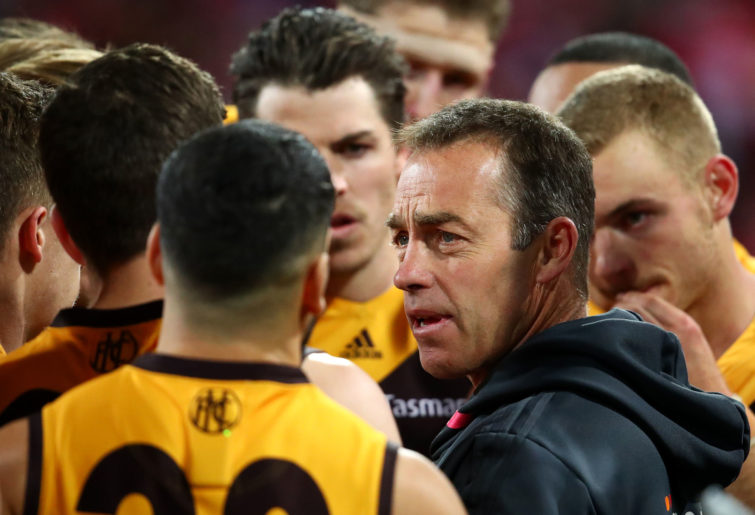WATCH: 'Gets umpired harshly' - Ginnivan caught HTB despite being taken high AND getting a handball
Death, taxes, and Jack Ginnivan getting ignored!
Opinion
I read with interest the comments from Alastair Clarkson about his criticism of the state of the game.
However, even now I am still unsure what Clarkson was really on about.
Was it about the state of the game? Was it about the lack of free kicks for tackles? Maybe it was about the free kicks that were paid against Hawthorn in the ruck?
Interestingly, Clarkson has been the coaching genius that has shaped how the game is played today. Now he is complaining!
However, as per normal, all the commentators jumped on board with ideas rehashed from last year and the year before and from before that. Same old crisis every year.
Why is the tackle issue suddenly so important to Clarkson?

(Photo by Cameron Spencer/AFL Photos/via Getty Images)
Not paying free kicks for good tackles has been building since the Tigers’ grand final victory in 2017. Last July, when Steve Hocking was talking on breakfast radio about Geelong’s win over St Kilda and the 161 tackles applied, he said: “Certainly we don’t want (tackling) as a skill”.
He wanted to “balance out” the tackling but did not explain how he intended to do that. Maybe “balancing out” is code for “don’t reward the tackler”.
Maybe Clarkson should be blaming him, not the umpires?
Tackling has always been an integral part of our game. The ability of players like Scott Pendlebury to avoid being tackled and still find good options is a skill. This is what makes him a star even for us non-Collingwood supporters.
The problem according to all the old-timers is that the improvement in the skill of tackling has been at the detriment of free-flowing footy. But has tackling caused the congestion around the ball or has the congestion increased the number of tackles?
Let’s assume for a moment that the real problem is congestion. Will paying a free kick for a good tackle change anything? I think not.
Let’s just say it takes ten seconds for the free to be paid and the ball to be returned to the tackler. In ten seconds, most AFL players can run the 50 metres to the next line of scrimmage. The defence will reset, and the next crowded contest will ensue.
A free kick in modern footy is a bit like trench warfare. The defence is arranged in lines one kick forward of the ball. As the ball moves forward, the defence folds back and reforms until all the defenders are back in the defensive 50 metre arc. Each retreat condenses the space and increases the congestion.
The defensive structures are so good, I really question whether winning a free kick is better than a ball up. At least winning a clearance from a ball up means breaking into free space.

(Photo by Michael Willson/AFL Media/Getty Images)
At some stages against the Tigers, Hawthorn had 12 or more defenders in their defensive 50. Tigers forwards had no space to lead into. Their tall forwards were blocked from even getting to the contest.
Once the ball was turned over, the Hawks did a series of shorts kicks to give their forwards time to run into their own forward line. I assume the Hawks did the same to the Roos. Clearly this was a strategy from Clarkson.
I suspect some of the problem was created by the shortened quarters. The players can sustain this mad-dash type of footy for 16 minutes. I doubt they could do it for 25 minutes for four quarters. Clarkson is a master of seizing the advantage.
These tactics were clearly well thought-out and very effective against the Tigers’ chaos. That’s why I am confused as to why Clarkson is panning the state of the game. It’s his game plan!
The Hawks saturation-style defence inside the 50-metre arc does, however, demonstrate flaws with the solutions to congestion put forward by the commentators that jumped onto Clarkson’s comments.
For example, take the idea of reducing the number of players to 16 per side. In reality, if Clarkson can get 12 out of 18 players into the back 50, he could just as easily get 12 out of 16.
The same applies to restricting interchanges. If you must rest players on the field, the best spot to rest them is in the back 50-metre arc. Restricting interchanges may decrease congestion in the midfield but actually increase congestion inside the 50-metre arcs.
One suggestion may work. Forcing forwards and defenders to stay in their own half combined with restricting some to within their 50-metre arc may work.
It could be done using electronic transponders that flashed after a present time when a player crosses a buried signal wire.
However, before it should even be considered, we should spend a lot of time trying to work out how Clarkson might turn the system to his advantage. Then complain about it. Just joking.